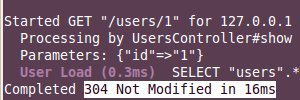I have to admit this . I always fall in love with RAILS each day as I explore it to know how a complex problem can be handle with great ease and with minimum amount of code.
That what made me write this post on " Conditional Get Request."
For those who aren’t aware of it let me give them some insight in it.
Conditional GETs are a feature of the HTTP specification that provide a way for web servers to tell browsers that the response to a GET request hasn’t changed since the last request and can be safely pulled from the browser cache.
They work by using the HTTP_IF_NONE_MATCH and HTTP_IF_MODIFIED_SINCE headers to pass back and forth both a unique content identifier and thetimestamp of when the content was last changed. If the browser makes a request where the content identifier (etag) or last modified since timestamp matches the server’s version then the server only needs to send back an empty response with a not modified status.
Enough of talk now its time for the action (Way to achieve it in Rails)
class UsersController < ApplicationController
def show
@user = User.find(params[:id])
fresh_when :last_modified => @user.last_updated_at ,:etag => @user
end
end
That it done
Now let check the logs to find, does it actually asking browser to read from its cache.
First time the page will completely render but any subsequent query for the same page will ask the browser to display from its cache(browser cache) (until modified).
Here my log :-

Other way to achieve the same is.
def show
@user = User.find(param[:id])
if stale?(:last_modified_at => @user.updated_at,:etag => @user)
repsond_to do |format|
format.html
end
end
end
def show
@user = User.find(params[:id])
response.last_modified = @user.updated_at
response.etag = @user
if request.fresh?(response)
head :not_modified
else
respond_to do |format|
format.html
end
end
end
The Following Code should give you same result as above
That it , thats all it take to get " Conditional GET " working in Rails. Wasn’t I right when I said that I fall in love with Rails each day.
Usage :-
Now most of you might be wondering where can they employ this technique or when should they use it
My Answer to them is think of Conditional Get a kind of Caching Mechanism ( after that what browser is doing for you)
Now suppose you have a method in controller that make large number of Database queries or ERB template that render a lot of contents on per requests .Wrapping the same with " Conditional GET " can simply do a lot of good.
That it enough on " Conditional GET " . Hope the post help you in some way or other.
Thank You .
5 comments On Conditional GET
Pingback: Tweets that mention Conditional GET | railstech | RORLAMP Development | Amar Daxini -- Topsy.com ()
nice,
Unfortunately in most cases “Conditional Get Request” won’t save DB hits … you need to count etag out of that, right? But it saves rendering time and network traffic which is good enough for me
There’s also a video some dork created on the topic over here: http://railslab.newrelic.com/2009/02/26/episode-11-advanced-http-caching
Conditional GET is something more people need to be aware of, since it’s proper usage can make a big different in perceived performance of a website.
While it’s more appropriate for APIs, I’ve found that Conditional PUT and DELETE are extremely useful too. They use HTTP_IF_MATCH and HTTP_IF_UNMODIFIED_SINCE, but otherwise they are very similar to how Conditional GET works.
The idea with them is that you only update/delete a resource when it hasn’t been modified since your last request. Effectively this allows you to do optimistic locking via pure HTTP, very similar to how lock_version/updated_at can be used in ActiveRecord for the same thing.